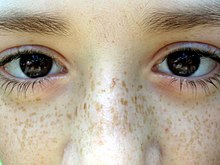Freckle
This article needs additional citations for verification. (February 2022) |
| Freckle | |
|---|---|
| Other names | Ephelides, ephelis |
 | |
| Slight facial freckles on a child | |
| Specialty | Dermatology |
Freckles are clusters of concentrated
Biology
The formation of freckles is caused by exposure to sunlight. The exposure to UV-B radiation activates melanocytes to increase melanin production, which can cause freckles to become darker and more visible. This means that one who has never developed freckles may develop them suddenly following extended exposure to sunlight.
Freckles are predominantly found on the face, although they may appear on any skin exposed to the sun, such as arms or shoulders. Heavily distributed concentrations of melanin may cause freckles to multiply and cover an entire area of skin, such as the face. Freckles are rare on infants, and more commonly found on children before puberty. Upon exposure to the sun, freckles will reappear if they have been altered with
Freckles are not a skin disorder, but people with freckles generally have a lower concentration of photo-protective melanin, and are therefore more susceptible to the harmful effects of UV radiation. It is suggested that people whose skin tends to freckle should avoid overexposure to sun and use sunscreen.[3][4]
Genetics

The presence of freckles is related to rare alleles of the
The variants of the MC1R gene that are linked with freckles started to emerge in the human genotype when humans started to leave Africa. The variant Val92Met arose somewhere between 250,000 and 100,000 years ago, long enough for this gene to be carried by humans into central

Types
Ephelides describes a freckle that is flat and light brown or red and fades with a reduction of sun exposure. Ephelides are more common in those with light complexions, although they are found on people with a variety of skin tones. The regular use of sunblock can inhibit their development.
In culture
Western societies traditionally perceived freckles as imperfections.[10] For example, Pliny the Elder described freckles as spiritual and religious stains.[11]
This perception changed after the mid-20th century, when a tan, and the freckles associated with it, came to be desired as a status symbol indicating a life of leisure.[10] Freckles became increasingly fashionable in the late 20th century as a result of the 1960s "youthquake" movement and through association with popular figures such as the model Twiggy and the musician Jane Birkin.[10] In the early 2000s, freckled models were a trend in advertising and fashion.[10]
By the 2020s, the popularity of freckle tattoos further increased due to their popularity on social media such as TikTok.[10]
See also
- Beauty mark
- List of Mendelian traits in humans
- Melanocortin 1 receptor
- Mole
References
- ISBN 0-8089-2302-1.
- ^ "Possible medical facial blemish or condition unknown term".
- S2CID 13999532.
- PMID 1546792.
- ^ PMID 11030758.
- ^ PMID 11487574.
- PMID 11179997.
- PMID 22854540.
- ^ PMID 10733465.
- ^ ISSN 0362-4331. Retrieved 2023-07-05.
- ISBN 978-0-292-72507-2.. Citing Pliny, Natural History, 28.188, 30.16
